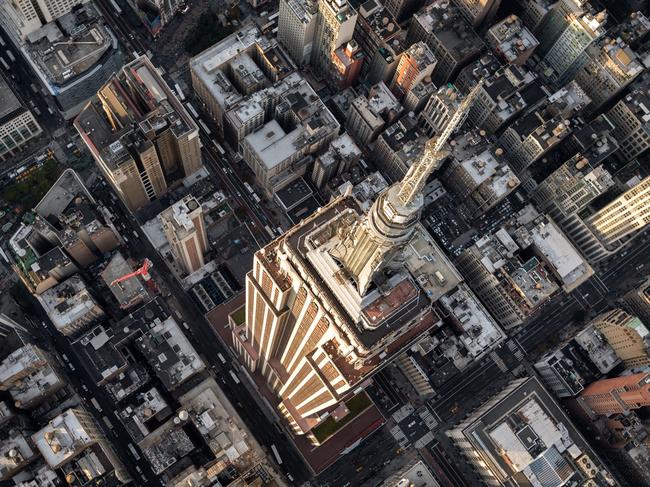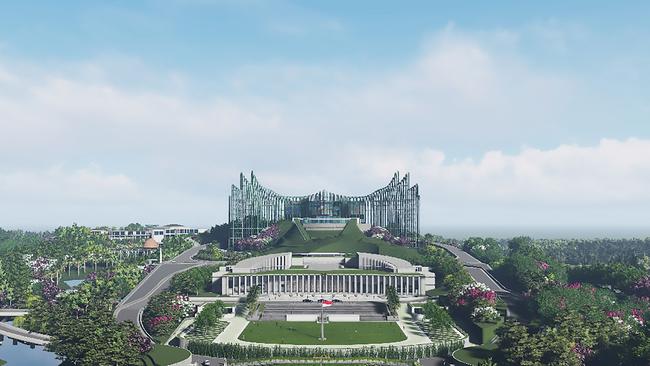New York City is sinking under the weight of its skyscrapers
A major city is sinking under the weight of its own humungous skyscrapers and it’s not the only one.

Climate Change
Don't miss out on the headlines from Climate Change. Followed categories will be added to My News.
It’s survived aliens and zombies, ice sheets and asteroid strikes. But there may be one thing New York City can’t escape. And that’s its own weight.
Manhattan Island’s skyscrapers are sinking.
But it’s not the leading contender to be the next Atlantis.
That honour goes to the Indonesian capital, Jakarta. It’s sinking at a remarkable 11cm each year.
The Big Apple, however, has been the subject of a new study assessing satellite measurements and analysing geological layers.
It proves the weight of the city’s upward urban bloat is proving too much for the soil beneath it to bear. Soft sediments are shifting under the relentless load, pushing them down and outwards.
The one million buildings housing eight million people weigh a combined 764 billion kilograms. This is causing New York City to subside at up to 2mm yearly.
And while it may not sound like much, parts of Lower Manhattan stand just one metre above sea level.
At the current rate, king tides may be rolling down its streets within a few short decades once the effects of rising sea levels are considered.
“Every additional high-rise building constructed at coastal, river, or lakefront settings could contribute to future flood risk,” warns United States Geological Survey geologist Tom Parsons.
The burden of wealth
Mr Parsons and his team of researchers have mapped the city’s weight distribution on a 100-by-100-meter grid. This doesn’t include the weight of asphalt roads, brick bridges or concrete pavements.
This was then overlaid on survey maps showing the complex weave of sand, silt, clay and bedrock sitting beneath.
Naturally, the bedrock outcrops haven’t budged much.
But the many buildings sitting on clay-rich soils and land-reclamation fill are most at risk.
By combining these soil and weight figures with decades worth of satellite land surface height measurements, the team has produced a subsidence forecast map for the whole city.
And they warn the risk will only accelerate if building intensities increase further and groundwater extraction projects continue.
“New York is emblematic of growing coastal cities all over the world that are observed to be subsiding, meaning there is a shared global challenge of mitigation against a growing inundation hazard,” the researchers state.

Coastal areas worldwide are at increased risk of flooding due to global warming. And recent studies show sea levels are rising at an unexpectedly rapid rate.
Coastal centres are expected to be confronted with severe challenges in the near future, with erosion and tidal flooding already becoming an increasingly common occurrence.
But the effect of infrastructure-caused subsidence is one element not included in most projections.
Atlantis in motion
Indonesia’s capital, Jakarta, could be largely underwater by 2050.
Decades of changing land use and groundwater extraction are causing parts of the city to sink by up to 11cm each year – even as sea levels rise by about 5mm in the same time frame.
The outcome is so bleak the Indonesian government has already implemented plans to relocate much of its 30 million people to a new city being carved out of the jungle 1300km away on the island of Borneo.

But it’s trying to buy time for the massive infrastructure build needed to establish East Kalimantan by ordering “groundwater free zones” around its heavy high-rise buildings from August this year.
The move will require piped water mains to be accessed by all residents and heavy promotion of recycled water systems. And all private and commercial wells – many of which are already illegal to avoid high utility costs – are to be banned.
It’s not going to solve the immediate problem.

No slowing in the 11cm-per-year rate subsidence is expected to be apparent for at least 10 to 20 years.
Only the construction of significant seawalls and embankments along Jakarta’s 30km coastline can hope to stave off tidal flooding before then.
Jakarta’s subsidence began in the 18th century after Dutch colonialists cleared the local forests to make way for plantations. This led to substantial soil erosion, forming a large new sandy delta where the Ciliwung River flowed into the sea.
A century later, that same uncompacted sand became the site of a new city. And unrelenting extraction of freshwater from the soil ever since has caused it to weaken and contract.
“This deep groundwater cannot be replenished immediately since the process is slow and can take up to 100 years,” University of Indonesia Environmental Engineering researcher Firdaus Ali warns.
“Meanwhile, the shallow groundwater can only be replenished during the rainy season. When the pores in the soil are left empty with loads pressing down from above, the land subsides.”
Jamie Seidel is a freelance writer | @JamieSeidel
More Coverage
Originally published as New York City is sinking under the weight of its skyscrapers





